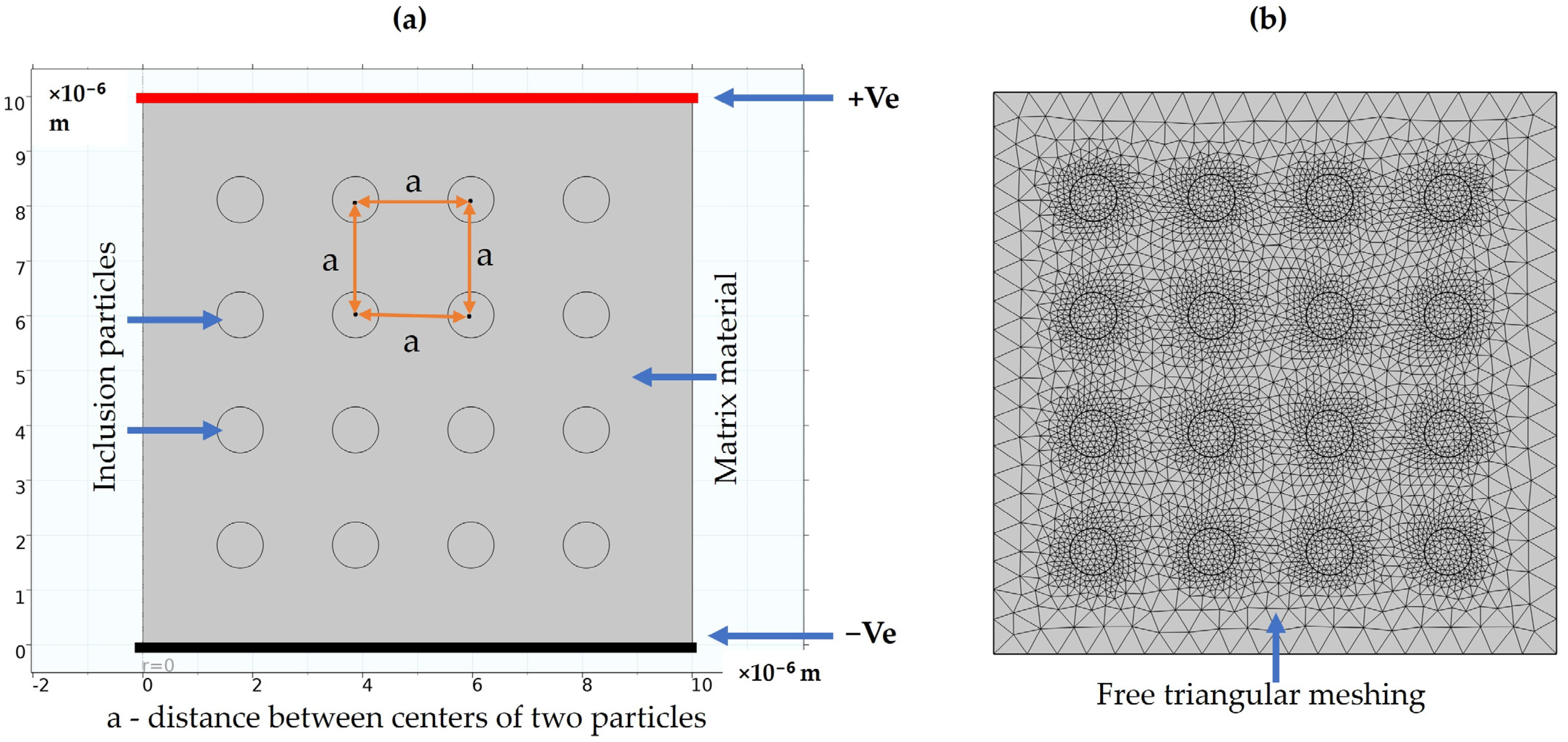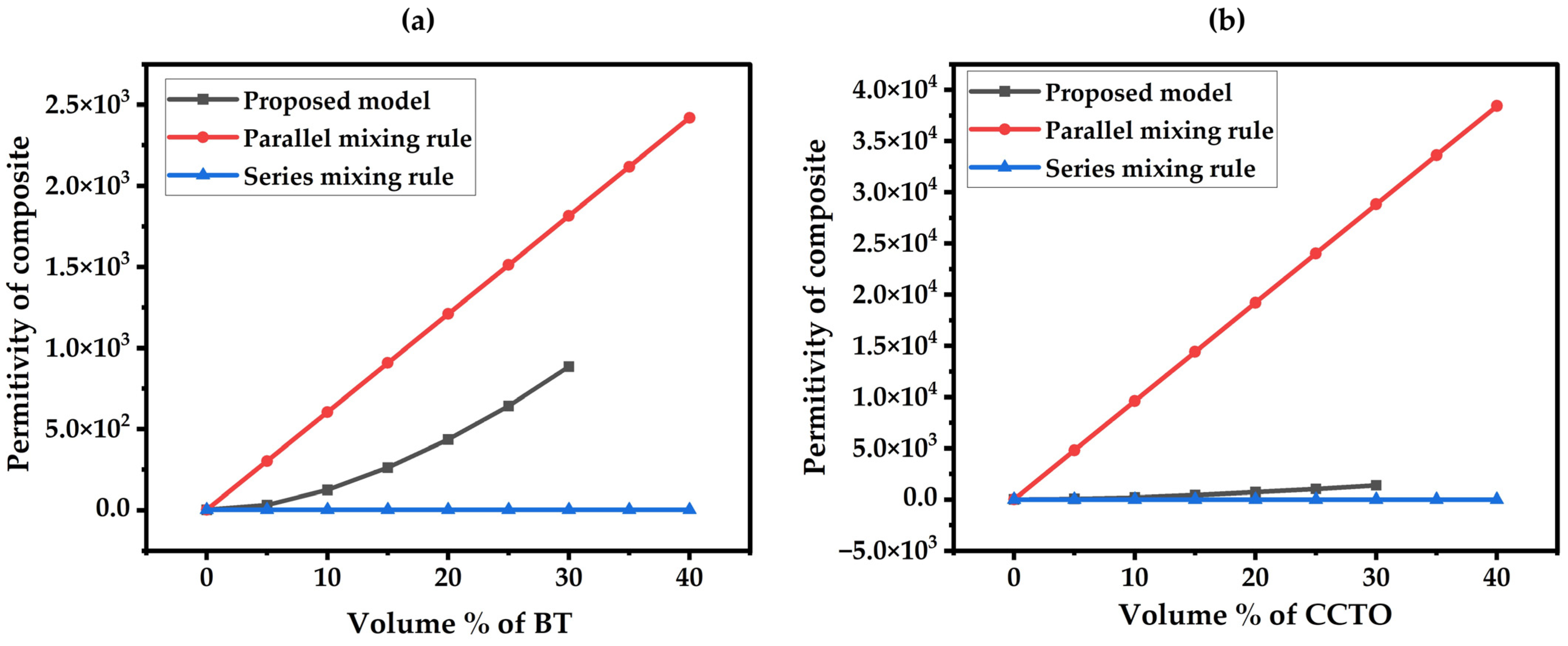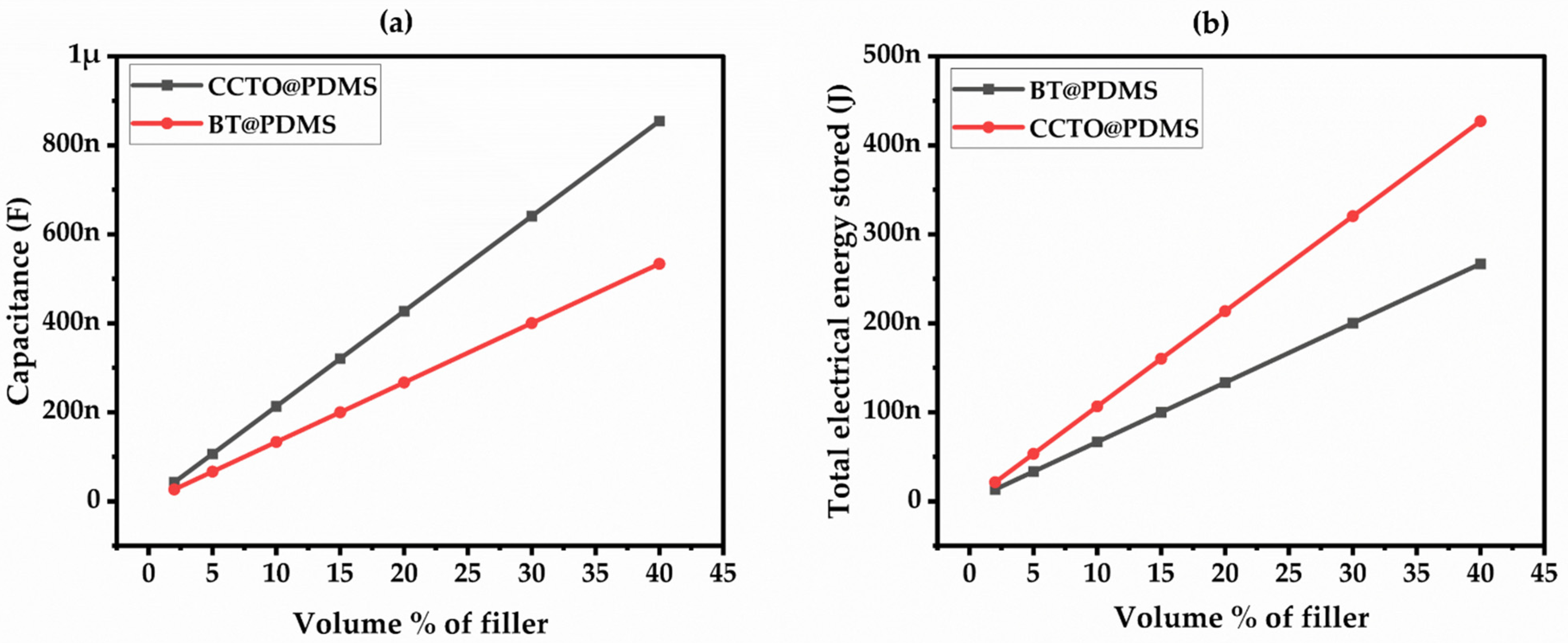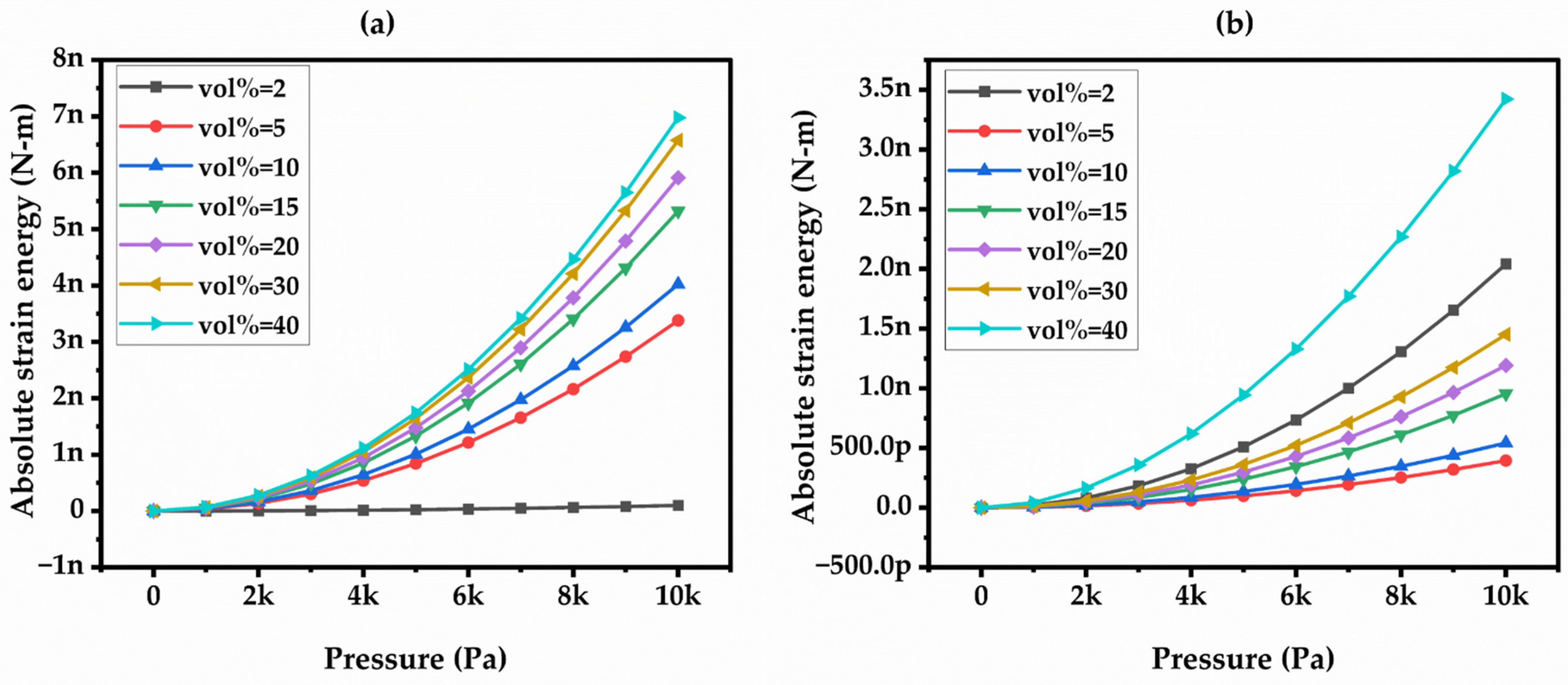Analysis of Polymer-Ceramic Composites Performance on Electrical and Mechanical Properties through Finite Element and Empirical Models
Abstract
1. Introduction
2. Materials and Methods
2.1. Empirical Models for Binary Composites
2.2. Empirical Model for the Present Study
Effective Dielectric Constant (
2.3. Interfacial Polarization
2.4. Modeling a Capacitive Pressure Sensor
2.5. Modeling of Composite Material
3. Results and Discussion
4. Conclusions
Author Contributions
Funding
Institutional Review Board Statement
Informed Consent Statement
Data Availability Statement
Acknowledgments
Conflicts of Interest
Abbreviations
| MWS | Maxwell-Wagner-Sillars |
| BT | Barium Titanate |
| CCTO | Calcium Copper Titanate Oxide |
| EMT | Effective Medium Theory |
| FEM | Finite Element Method |
| ANN | Artificial Neural Networks |
| CAD | Computer Aided Design |
| CPS | Capacitive Pressure Sensor |
| 2D | Two-Dimensional |
| 3D | Three-Dimensional |
References
- Zhang, C.; Chi, Q.; Dong, J.; Cui, Y.; Wang, X.; Liu, L.; Lei, Q. Enhanced dielectric properties of poly(vinylidene fluoride) composites filled with nano iron oxide-deposited barium titanate hybrid particles. Sci. Rep. 2016, 6, 33508. [Google Scholar] [CrossRef]
- Ayatollahi, M.R.; Shadlou, S.; Shokrieh, M.M.; Chitsazzadeh, M. Effect of multi-walled carbon nanotube aspect ratio on mechanical and electrical properties of epoxy-based nanocomposites. Polym. Test. 2011, 30, 548–556. [Google Scholar] [CrossRef]
- Zhang, F.; Li, J.; Wang, T.; Huang, C.; Ji, F.; Shan, L.; Zhang, G.; Sun, R.; Wong, C. Fluorinated graphene/polyimide nanocomposites for advanced electronic packaging applications. J. Appl. Polym. Sci. 2021, 138, 49801. [Google Scholar] [CrossRef]
- Elbayoumy, E.; El-Ghamaz, N.A.; Mohamed, F.S.; Diab, M.A.; Nakano, T. Dielectric Permittivity, AC Electrical Conductivity and Conduction Mechanism of High Crosslinked-Vinyl Polymers and Their Pd(OAc)2 Composites. Polymers 2021, 13, 3005. [Google Scholar] [CrossRef]
- Yoon, D.-H.; Zhang, J.; I Lee, B. Dielectric constant and mixing model of BaTiO3 composite thick films. Mater. Res. Bull. 2003, 38, 765–772. [Google Scholar] [CrossRef]
- Shivashankar, H.; Mathias, K.A.; Sondar, P.R.; Shrishail, M.H.; Kulkarni, S.M. Study on low-frequency dielectric behavior of the carbon black/polymer nanocomposite. J. Mater. Sci. Mater. Electron. 2021, 32, 28674–28686. [Google Scholar] [CrossRef]
- Wiens, A.; Kohler, C.; Hansli, M.; Schuessler, M.; Jost, M.; Maune, H.; Binder, J.R.; Jakoby, R. CAD-assisted modeling of high dielectric contrast composite materials. J. Eur. Ceram. Soc. 2017, 37, 1487–1494. [Google Scholar] [CrossRef]
- Ji, S.; Jeong, D.-Y.; Kim, C.; Yi, S. High Dielectric Design of Polymer Composites by Using Artificial Neural Network. Appl. Sci. 2022, 12, 12592. [Google Scholar] [CrossRef]
- Simpkin, R. Derivation of lichtenecker’s logarithmic mixture formula from maxwell’s equations. IEEE Trans. Microw. Theory Tech. 2010, 58, 545–550. [Google Scholar] [CrossRef]
- Levy, O.; Stroud, D. Maxwell Garnett theory for mixtures of anisotropic inclusions: Application to conducting polymers. Phys. Rev. B Condens. Matter Mater. Phys. 1997, 56, 8035–8046. [Google Scholar] [CrossRef]
- Koledintseva, M.Y.; DuBroff, R.E.; Schwartz, R.W. A Maxwell Garnett model for dielectric mixtures containing conducting particles at optical frequencies. Prog. Electromagn. Res. 2006, 63, 223–242. [Google Scholar] [CrossRef]
- Goncharenko, A.V.; Lozovski, V.Z.; Venger, E.F. Lichtenecker’s Equation: Applicability and Limitations. 2000. Available online: https://www.sciencedirect.com/science/article/abs/pii/S0030401899006951 (accessed on 16 November 1999).
- Sundar, U.; Lao, Z. Cook-Chennault Enhanced dielectric permittivity of optimized surface modified of barium titanate nanocomposites. Polymers 2020, 12, 827. [Google Scholar] [CrossRef]
- Lu, Y.; Qin, Q.; Meng, J.; Mi, Y.; Wang, X.; Cao, X.; Wang, N. Constructing highly flexible dielectric sponge for enhancing triboelectric performance. Chem. Eng. J. 2023, 468, 143802. [Google Scholar] [CrossRef]
- Zhang, Z.; Hu, L.; Wang, R.; Zhang, S.; Fu, L.; Li, M.; Xiao, Q. Advances in Monte Carlo Method for Simulating the Electrical Percolation Behavior of Conductive Polymer Composites with a Carbon-Based Filling. Polymers 2024, 16, 545. [Google Scholar] [CrossRef]
- Tran, M. Evidence for Maxwell’s equations, fields, force laws and alternative theories of classical electrodynamics. Eur. J. Phys. 2018, 39, 063001. [Google Scholar] [CrossRef]
- Kakati, B.; Sathiyamoorthy, D.; Verma, A. Semi-empirical modeling of electrical conductivity for composite bipolar plate with multiple reinforcements. Int. J. Hydrogen Energy 2011, 36, 14851–14857. [Google Scholar] [CrossRef]
- Vadakkepatt, A.; Trembacki, B.; Mathur, S.R.; Murthy, J.Y. Bruggeman’s Exponents for Effective Thermal Conductivity of Lithium-Ion Battery Electrodes. J. Electrochem. Soc. 2016, 163, A119–A130. [Google Scholar] [CrossRef]
- Looyenga, H. Dielectric constants of heterogeneous mixtures. Physica 1965, 31, 401–406. [Google Scholar] [CrossRef]
- Talebian, E.; Talebian, M. A general review on the derivation of Clausius–Mossotti relation. Optik 2013, 124, 2324–2326. [Google Scholar] [CrossRef]
- Starczewska, A.; Mistewicz, K.; Kozioł, M.; Zubko, M.; Stróż, D.; Dec, J. Interfacial Polarization Phenomena in Compressed Nanowires of SbSI. Materials 2022, 15, 1543. [Google Scholar] [CrossRef]
- Keshyagol, K.; Hiremath, S.; M., V.H.; Kini U, A.; Naik, N.; Hiremath, P. Optimizing Capacitive Pressure Sensor Geometry: A Design of Experiments Approach with a Computer-Generated Model. Sensors 2024, 24, 3504. [Google Scholar] [CrossRef] [PubMed]
- Keshyagol, K.; Hiremath, S.; M., V.H.; Hiremath, P. Estimation of Energy Storage Capability of the Parallel Plate Capacitor Filled with Distinct Dielectric Materials. Eng. Proc. 2023, 59, 95. [Google Scholar] [CrossRef]
- Renteria, A.; Diaz, J.A.; He, B.; Renteria-Marquez, I.A.; Chavez, L.A.; Regis, J.E.; Liu, Y.; Espalin, D.; Tseng, T.L.B.; Lin, Y. Particle size influence on material properties of BaTiO3 ceramics fabricated using freeze-form extrusion 3D printing. Mater. Res. Express 2019, 6, 115211. [Google Scholar] [CrossRef]
- Sikulskyi, S.; Mekonnen, D.T.; El Atrache, A.; Divo, E.; Kim, D. Effects of Ferroelectric Fillers on Composite Dielectric Elastomer Actuator. Actuators 2021, 10, 137. [Google Scholar] [CrossRef]
- Ramírez, M.; Parra, R.; Reboredo, M.; Varela, J.; Castro, M.; Ramajo, L. Elastic modulus and hardness of CaTiO3, CaCu3Ti4O12 and CaTiO3/CaCu3Ti4O12 mixture. Mater. Lett. 2010, 64, 1226–1228. [Google Scholar] [CrossRef]
- Iravani, S.; Korbekandi, H.; Mirmohammadi, S.V.; Zolfaghari, B. Synthesis of silver nanoparticles: Chemical, physical and biological methods. Res. Pharm. Sci. 2014, 9, 385–406. [Google Scholar] [PubMed]
- Pearce, P.; Mellor, A.; Ekins-Daukes, N. The importance of accurate determination of optical constants for the design of nanometallic light-trapping structures. Sol. Energy Mater. Sol. Cells 2019, 191, 133–140. [Google Scholar] [CrossRef]
- You, Y.; Chen, S.; Yang, S.; Li, L.; Wang, P. Enhanced Thermal and Dielectric Properties of Polyarylene Ether Nitrile Nanocomposites Incorporated with BN/TiO2-Based Hybrids for Flexible Dielectrics. Polymers 2023, 15, 4279. [Google Scholar] [CrossRef] [PubMed]
- Lebedev, O.V.; Ozerin, A.N.; Abaimov, S.G. Multiscale Numerical Modeling for Prediction of Piezoresistive Effect for Polymer Composites with a Highly Segregated Structure. Nanomaterials 2021, 11, 162. [Google Scholar] [CrossRef]
- Wang, Y.; Li, B.; Zhu, F.; Gao, H.; Wu, Q. Polymerization of styrene using novel bispyrazolylimine dinickel (II)/methylaluminoxane catalytic systems. J. Appl. Polym. Sci. 2011, 122, 545–550. [Google Scholar] [CrossRef]
- Norizan, M.N.; Shazleen, S.S.; Alias, A.H.; Sabaruddin, F.A.; Asyraf, M.R.M.; Zainudin, E.S.; Abdullah, N.; Samsudin, M.S.; Kamarudin, S.H.; Norrrahim, M.N.F. Nanocellulose-Based Nanocomposites for Sustainable Applications: A Review. Nanomaterials 2022, 12, 3483. [Google Scholar] [CrossRef]
- Gupta, A.; Goyal, R.K. Electrical properties of polycarbonate/expanded graphite nanocomposites. J. Appl. Polym. Sci. 2019, 136, 47274. [Google Scholar] [CrossRef]
- Guo, C.; Fuji, M. Effect of silicone coupling agent on dielectric properties of barium titanate/silicone elastomer composites. Adv. Powder Technol. 2016, 27, 1162–1172. [Google Scholar] [CrossRef]
- Dinulović, M.; Rašuo, B. Dielectric modeling of multiphase composites. Compos. Struct. 2011, 93, 3209–3215. [Google Scholar] [CrossRef]
- Djouada, D.; Bouzit, N.; Delfouf, R.; Chioukh, L.; Jiménez, J.P.M. Dielectric Characterization of Heterogeneous Composites Using Time Domain Spectroscopy and Microwave Test Benches in Microwave Frequency. ECS J. Solid. State Sci. Technol. 2023, 12, 063003. [Google Scholar] [CrossRef]
- Araújo, M.C.; Costa, C.; Lanceros-Méndez, S. Evaluation of dielectric models for ceramic/polymer composites: Effect of filler size and concentration. J. Non Cryst. Solids 2014, 387, 6–15. [Google Scholar] [CrossRef]
- Kharabet, I.; Tatarchuk, D.; Didenko, Y.; Patsora, I. Modeling of parameters of composite metal-polymer systems. In Proceedings of the 2014 20th International Conference on Microwaves, Radar and Wireless Communications (MIKON), Gdansk, Poland, 16–18 June 2014; pp. 1–4. [Google Scholar] [CrossRef]
- Shivashankar, H.; Kevin, A.; Manohar, S.; Kulkarni, S. Investigation on dielectric properties of PDMS based nanocomposites. Phys. B Condens. Matter 2021, 602, 412357. [Google Scholar] [CrossRef]
- Drozdov, A.; Christiansen, J.D. Modeling dielectric permittivity of polymer composites at microwave frequencies. Mater. Res. Bull. 2020, 126, 110818. [Google Scholar] [CrossRef]
- Wang, Z.; Nelson, J.K.; Hillborg, H.; Zhao, S.; Schadler, L.S. Dielectric constant and breakdown strength of polymer composites with high aspect ratio fillers studied by finite element models. Compos. Sci. Technol. 2013, 76, 29–36. [Google Scholar] [CrossRef]
- Abraham, R.; Guo, R.; Bhalla, A.S. Modeling Permittivity and Tangent Loss in Dielectric Materials Using Finite Element Method and Monte Carlo Simulation. Ferroelectrics 2005, 315, 1–15. [Google Scholar] [CrossRef]
- Padurariu, L.; Curecheriu, L.P.; Mitoseriu, L. Nonlinear dielectric properties of paraelectric-dielectric composites described by a 3D Finite Element Method based on Landau-Devonshire theory. Acta Mater. 2016, 103, 724–734. [Google Scholar] [CrossRef]
- Ramajo, L.; Reboredo, M.; Santiago, D.; Castro, M.; Ramajo, D. Computational Approach of Dielectric Permitivities in BaTiO3—Epoxy Composites. J. Compos. Mater. 2008, 42, 2027–2037. [Google Scholar] [CrossRef]











| Materials | Permittivity (ε) | Young’s Modulus (E) [GPa] | Poisson’s Ratio (ν) | Density [kg/m3] | Particle Size [µm] | Ref. |
|---|---|---|---|---|---|---|
| PDMS | 2.4 | 0.00075 | 0.45 | 970 | - | [23] |
| BT | 6000 | 60 | 0.25 | 6000 | 0.42 | [24,25] |
| CCTO | 9600 | 256 | 0.25 | 4700 | 0.72 | [25,26] |
| Silver | 1.971 | 78 | 0.37 | 10.49 | - | [27] |
| Reference | Matrix | Filler | Empirical Model | Remarks |
|---|---|---|---|---|
| [1] | PVDF | BT | Bruggeman | Predicts permittivity for random BT distribution |
| [2] | Epoxy Resin | MWCNTs | Maxwell-Garnett | Applicable for high MWCNT concentrations |
| [3] | Polyimide | Graphene Oxide | Kerner | Accounts for filler-matrix interaction |
| [4] | PDMS | Calcium Copper Titanate oxide (CCTO) | Lichtenecker with Interfacial Correction | Considers interfacial polarization effects |
| [28] | BT | Nickel (Ni) | Effective Medium Theory (EMT) | Captures behavior of composite microstructure |
| [29] | Poly(methyl methacrylate) (PMMA) | Silver Nanowires | FEM | Simulates electric field distribution for complex geometries |
| [30] | Polyaniline (PANI) | Clay Nanoparticles | Multiscale Modeling (Combining Models) | Combines microscopic and macroscopic approaches |
| [31] | High-Density Polyethylene (HDPE) | BT Microspheres | Logarithmic Mixing Rule with Percolation Threshold | Simple model considering filler connectivity |
| [32] | Poly(lactic acid) (PLA) | Cellulose Nanofibers | Mori-Tanaka Model | Considers the effect of fiber orientation |
| [33] | Polycarbonate (PC) | Exfoliated Graphite Flakes | Dielectric Mixture Theory with Maxwell-Wagner-Sillars (MWS) | Captures interfacial effects at high frequencies |
| [34] | Benzocyclobutene (BCB) | Silicon Dioxide (SiO2) Nanoparticles | Self-Consistent Mean Field (SCMF) Theory | Powerful method for complex composites |
| [8] | Various Polymers | Various (potentially with shells) | Artificial Neural Network (ANN) | Predicts dielectric constant for material design in electrical energy storage |
| [35] | Bisphenol A diglycidylether Epoxy | Hollow Ceramic Spheres | Effective Medium Theory (Clausius-Mossoti relation) | Bisphenol A diglycidylether Epoxy |
| [5] | X7R BT Particles | BT Gel | Sigmoidal Fitting Function (based on Boltzmann equation) | Predicts dielectric constant of BT composite thick films with varying BT gel content. |
| [36] | Epoxy Resin (RE) | BT | Empirical Mixture Laws (unspecified) | Predicts dielectric permittivity of polymer-ceramic composites for energy storage applications |
| [7] | Barium Strontium Titanate (BST) | Magnesium Borate | CAD Approach. | Predicts effective dielectric properties of binary ceramic composites with high dielectric contrast. |
| [37] | Poly(vinylidene fluoride) (PVDF) | Lead Zirconium Titanate or BT | Maxwell-Garnett Ignores particle interactions. | Suitable for low filler concentrations. |
| Bruggeman Accounts for particle interactions to some extent. | Suitable for moderate filler concentrations. | |||
| Lichtenecker Ignores particle interactions | Suitable for high filler concentrations. | |||
| [38] | Polymer (ε′ = 2.73, ε″ = 0.2) | Aluminum powder | Nielsen’s equation | Predicts dielectric properties of metal-insulator composites for metal-insulators. |
| [6] | PDMS | CB | Various Models | Predicts dielectric permittivity |
| [39] | PDMS | CB | Wiener Model fits best | Predicts dielectric permittivity of PDMS/CB nanocomposites. |
| [40] | Various Polymer | Ceramic, Magnetic, CB | Modified Lichtenecker-Rother Model Accounts for aggregation of filler particles | Predicts complex permittivity of polymer composites considering filler cluster aggregation. |
| [41] | PDMS | BT | FEM | Analyzes dielectric constant, breakdown strength, and microstructure effects. |
| [42] | Polymer with permittivity (ε) = 3.02 | BT | FEM and Monte-Carlo methods | Compares effective permittivity and tangent loss with analytical models. |
| [43] | Lead Zirconate Titanate based composites with various microstructures | Combining Landau-Devonshire theory and FEM | proposes a valuable modeling tool for designing materials with tailored permittivity. | |
| [44] | Epoxy Resin | BT Particles | FEM with quasi-static approximation | Analyzes dielectric constant using periodic FCC structures with novel packing protocols. |
Disclaimer/Publisher’s Note: The statements, opinions and data contained in all publications are solely those of the individual author(s) and contributor(s) and not of MDPI and/or the editor(s). MDPI and/or the editor(s) disclaim responsibility for any injury to people or property resulting from any ideas, methods, instructions or products referred to in the content. |
© 2024 by the authors. Licensee MDPI, Basel, Switzerland. This article is an open access article distributed under the terms and conditions of the Creative Commons Attribution (CC BY) license (https://creativecommons.org/licenses/by/4.0/).
Share and Cite
Keshyagol, K.; Hiremath, S.; H. M., V.; Rao, P.K.; Hiremath, P.; Naik, N. Analysis of Polymer-Ceramic Composites Performance on Electrical and Mechanical Properties through Finite Element and Empirical Models. Materials 2024, 17, 3837. https://doi.org/10.3390/ma17153837
Keshyagol K, Hiremath S, H. M. V, Rao PK, Hiremath P, Naik N. Analysis of Polymer-Ceramic Composites Performance on Electrical and Mechanical Properties through Finite Element and Empirical Models. Materials. 2024; 17(15):3837. https://doi.org/10.3390/ma17153837
Chicago/Turabian StyleKeshyagol, Kiran, Shivashankarayya Hiremath, Vishwanatha H. M., P. Krishnananda Rao, Pavan Hiremath, and Nithesh Naik. 2024. "Analysis of Polymer-Ceramic Composites Performance on Electrical and Mechanical Properties through Finite Element and Empirical Models" Materials 17, no. 15: 3837. https://doi.org/10.3390/ma17153837
APA StyleKeshyagol, K., Hiremath, S., H. M., V., Rao, P. K., Hiremath, P., & Naik, N. (2024). Analysis of Polymer-Ceramic Composites Performance on Electrical and Mechanical Properties through Finite Element and Empirical Models. Materials, 17(15), 3837. https://doi.org/10.3390/ma17153837









